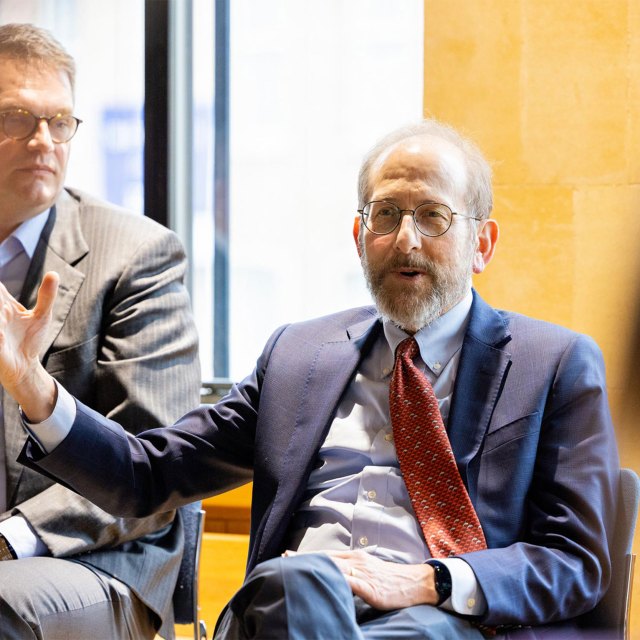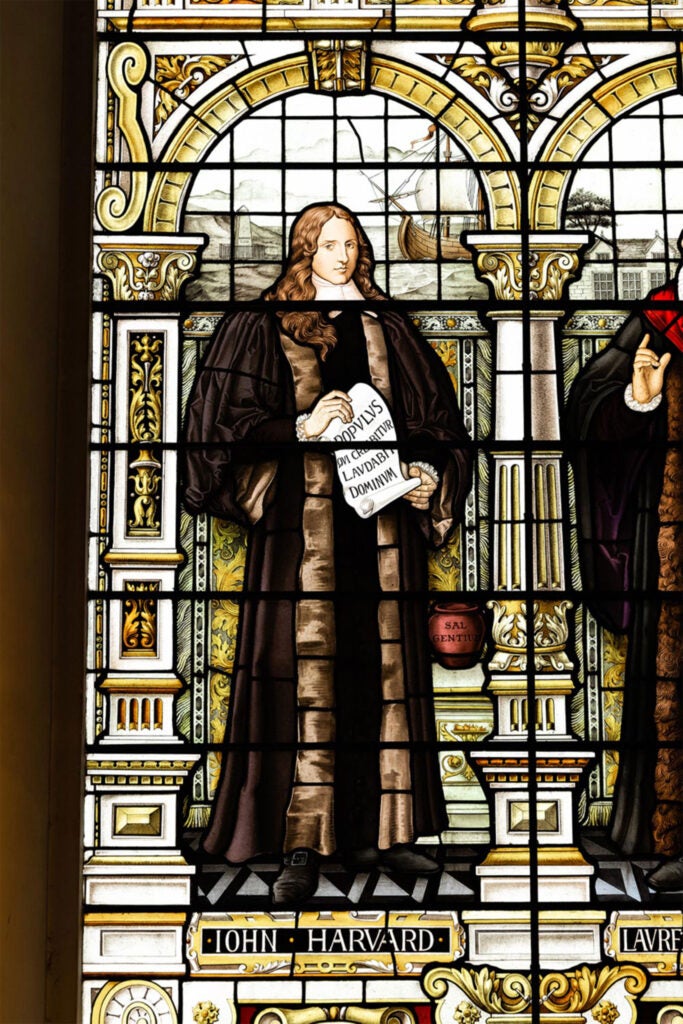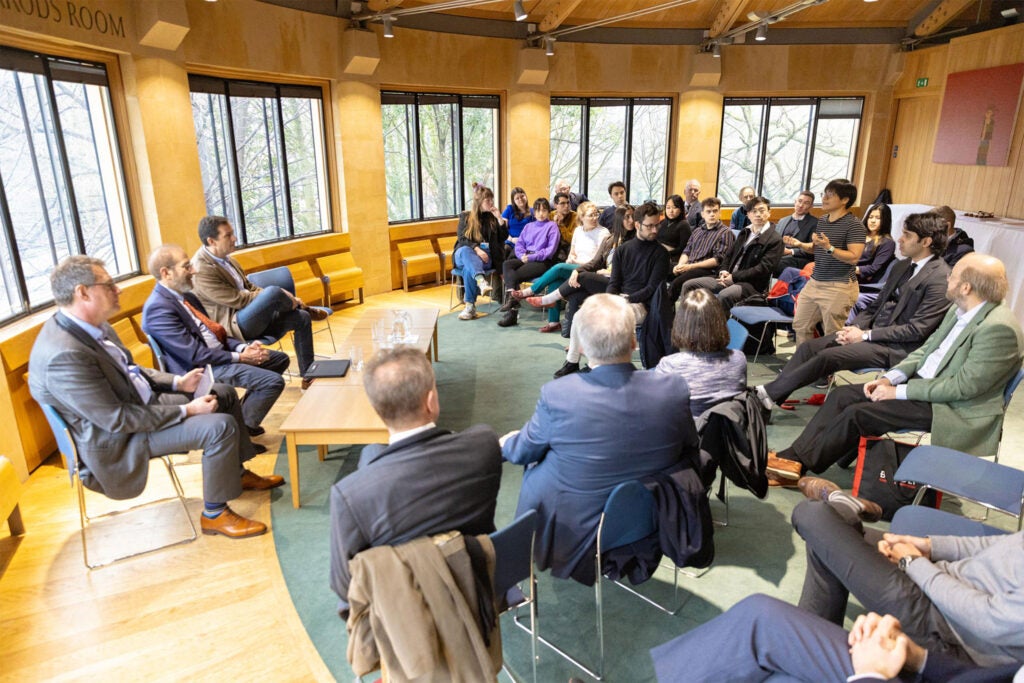
During his trip to the U.K., Interim President Alan Garber spoke with the Herchel Smith Scholars at Emmanuel College, Cambridge. Eric Miska (left), Herchel Smith Professor of Molecular Genetics, moderated the symposium.
Credit: Stillvision.co.uk
Garber emphasizes ‘critical collaboration’ in U.K. visit
Interim president meets with scholars and alumni in first international trip
Celebrating the “critical collaboration in the sciences” that brings together researchers “from different places who have been trained in different ways,” Alan Garber kicked off his first international trip as interim Harvard president with a visit to the University of Cambridge, where he met with students, faculty, and university leaders, toured Emmanuel College (the alma mater of John Harvard), and visited the Cambridge Biomedical Campus.
During the visit to the U.K., Garber also met with more than 200 alumni at an event in London, where he participated in a wide-ranging conversation with Dame Vivian Hunt, a graduate of Harvard College and Harvard Business School, chief innovation officer at UnitedHealth Group, and a member of Harvard’s Board of Overseers. The event was hosted by the Harvard Alumni Association in partnership with the Harvard Club of the United Kingdom, the largest of Harvard’s international clubs with over 800 members, and serving a community of over 8,000.
“It was a great pleasure to meet with our alumni in London and to travel to the University of Cambridge on my first presidential visit outside of the United States,” said Garber. “Acknowledging our historical roots and celebrating our ongoing connections underscored for me the strength of our worldwide community. It was inspiring to see firsthand the many ways in which that strength is helping us fulfill our commitment to teaching, research, and innovation. I am grateful to the vice chancellor and our colleagues in old Cambridge, and to our alumni community in London, for hosting me for these important conversations.”
Shared history
Garber’s engagements at Cambridge began with a meeting with Professor Deborah Prentice, who took office as Cambridge’s vice chancellor in July 2023. Discussions centered around areas of intersection between the two universities as well as ways to support collaborative initiatives in research, innovation, and academic leadership.
“I was delighted to welcome Professor Garber and the Harvard team to Cambridge,” said Prentice, a psychologist who formerly served as provost of Princeton University. “It was a wonderful opportunity to catch up with colleagues, discuss some of the great work going on in our institutions, and exchange ideas on a wide range of topics.”
Garber also met with Doug Chalmers, master of Emmanuel College, who showed the Harvard leader artifacts that involved John Harvard. After receiving both a Bachelor’s of Arts and a Master’s of Arts from Emmanuel College, Harvard and his wife sailed to New England and settled in Charlestown, Massachusetts. Upon his death in 1638, Harvard left half of his estate and his personal library to a newly founded college in Cambridge. The following year, the Massachusetts General Court named the college, now Harvard University, in his honor.

“The linkages between Harvard and Emmanuel are well known and ones that we treasure,” said Chalmers. “With students, heading both ways for summer projects or formal programs, our academic connections remain fresh and vibrant. And for those who take up the opportunity of studying in both Cambridges, the benefit of understanding and practicing different approaches and techniques sets strong foundations for groundbreaking collaborations. Alan Garber, during his recent visit, underlined all of these aspects and more. The future of collaboration between these two world-leading research universities is bright.”
The power of scientific exchange
While at Emmanuel, Garber participated in a symposium where professors, undergraduates, and doctoral students supported by the Herchel Smith Fund — which supports exchange between scientists at levels at Harvard and Cambridge — presented their work and discussed a range of issues facing scientists in today’s world. The conversation was moderated by Herchel Smith Professor of Molecular Genetics Eric Miska, the head of the Department of Biochemistry at Cambridge.
Carmem Gilardoni, a Herchel Smith Research Fellow and an experimental physicist working at the interface of material science and quantum optics, discussed work with layered materials that might advance quantum technological applications. She welcomed the conversation across issues confronting scientists around the world.

“I thought the symposium provided very interesting insights into the challenges and opportunities both institutions face, ranging from how they treat IP to how they create an environment that is conducive to interdisciplinarity and innovative ideas,” said Gilardoni. “It was particularly thought-provoking to hear from President Garber about how Harvard is adapting to new technologies and research models.”
Gilardoni also spoke about her field, saying it was “great to see that both Harvard and Cambridge share a vision for the development of quantum technologies — an area of increasing interest that, as President Garber mentioned, is extremely resource-intensive.”
Gilardoni said she hopes to contribute to joint efforts in the future.
Other presentations from the Smith scholars included work on the biochemical foundations of diseases such as dementia; the use of supramolecular cages to create unusual molecular reactions; and efforts to illuminate pathogenic diversity in the Dengue virus. Several attendees discussed their experiences of attending Harvard as part of the exchange program.
“One of the things that made me particularly impressed with the program was the exchange that occurs between the scholars at different levels, of course, at Cambridge and at Harvard,” said Garber at the roundtable. “Doug [Chalmers] and I were speaking very briefly before this meeting about the importance of physical presence for collaboration, and how despite all we’ve been through with COVID and Zoom and everything else, collaboration is so critical, particularly in the sciences. And there are some things we can do remotely but there is nothing yet that can replace the human interaction, meeting colleagues from different places who have been trained in different ways and may have somewhat different aspirations — but who share a common mission. This program is an example, in my view, of how that can be done.”
Following the symposium, Garber joined a lunch discussion with the Herchel Smith program participants and others, including Meredith Johns and Janna Ramadan, who are Harvard Cambridge Scholars.
Garber also visited the Cambridge Biomedical Campus, an international healthcare community that serves as home to leading academic research, university teaching hospitals, and industry scientists. Kristin-Anne Rutter, M.B.A. ’06, the executive director of Cambridge University Health Partners, led Garber through the university’s stem cell institute and provided an overview of the campus, which includes the new global headquarters of Astra Zeneca, the British-Swedish pharmaceutical and biotechnology firm responsible for the 2020 Oxford-Astra Zeneca COVID 19 vaccine.




